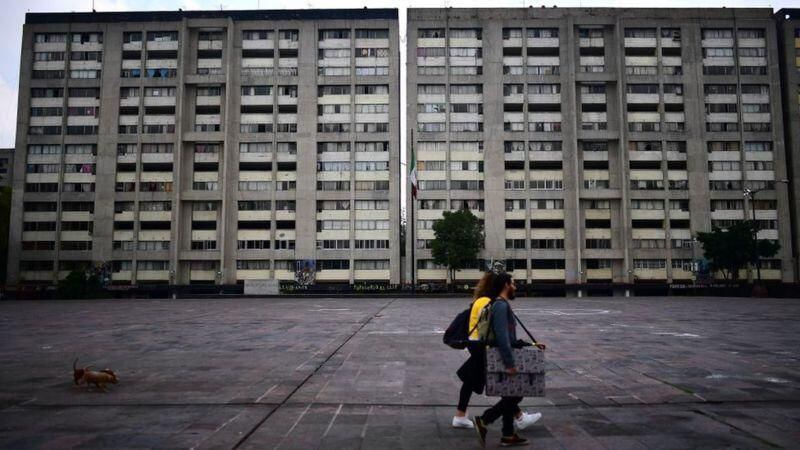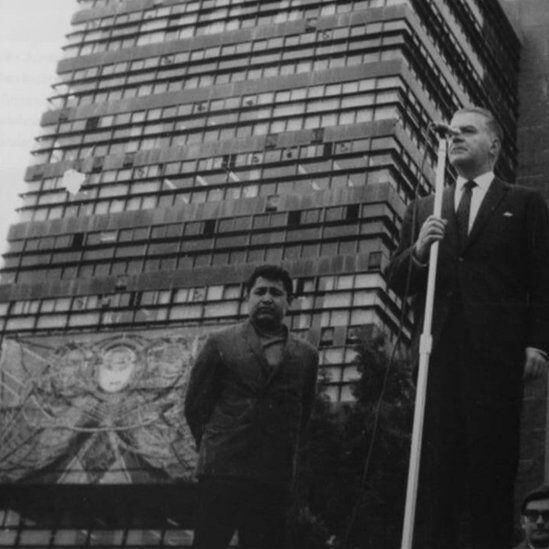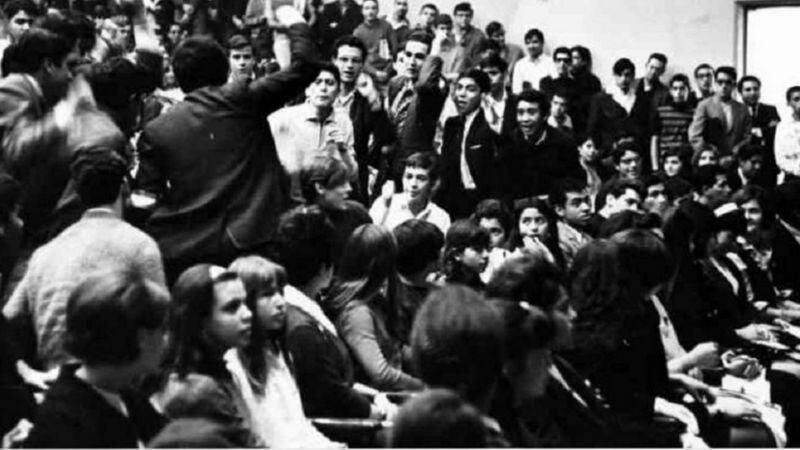The story that led to the massacre began with a student fight in the center of Mexico City.
The anti-riot group of the capital’s police, known as Grenadier Corps, intervened to calm the fight. But he did it in a brutal way.
LOOK: Consuelo Porras, the controversial Guatemalan attorney general whom Bernardo Arévalo accuses of orchestrating a “coup d’état”
He beat dozens of students and witnesses to the fight. He chased young people to the schools where they took refuge and also attacked students and teachers who taught there.
It was him July 23, 1968. At that time, the Mexican police had a reputation for committing abuses, but the aggression against students was excessive.
Four days later, students from National Autonomous University of Mexico (UNAM) it’s from National Polytechnic Institute (IPN) They organized a march against police violence.
But the march, which was joined by members of the Mexican Communist Party, was suppressed by the grenadiers.
From that moment on, a student movement began that grew rapidly in a few weeks. UNAM, IPN and other universities in the country declared themselves in strike.
Authorities reported burned buses and the explosion of explosive devices. Dozens of young people were detained and tanks and dozens of soldiers were positioned in the Zócalo, the country’s central square.
The Army occupied the UNAM and IPN facilities, but was unable to contain the movement grouped in the National Strike Council (CNH).
The rector of the National University, Javier Barros Sierra, resigned in protest against the invasion of university autonomy.
The movement was only contained until the afternoon of October 2nd. That day a meeting was called new protest march which would start from Square of the Three Cultures in Tlatelolco.
Hundreds of soldiers surrounded the place. When the students announced that the walk was canceled to avoid violence, gunfire broke out into the crowd.
More than fifty years later, it is still unclear where the shooting started. It is also unknown how many people were killed or injured.
But the attack became a watershed in the country’s history. Since October 2, 1968, Mexico was different, socially and politically different than the day before.
The previous decade

This is the story that is remembered every year during the anniversary of the massacre.
But little is said about social and political environment that existed in the country in those years, which motivated the accelerated growth of the student movement in 1968.
A moment that also explains the strong reaction of the government of then president Gustavo Díaz Ordaz.
From the 1950s and the following decade, a series of movements of doctors, railway workers, electricians, farmers and students were registered in the country.
In all cases, the protests were repressed by the police and military.

The student mobilizations of 1968 were a consequence of this long process, explains Gilberto Guevara Niebla, one of the founders of the CNH.
“He movement of 68 It would not be understood if we did not consider that at that time there was an authoritarian and repressive regime”, he tells BBC Mundo.
“Especially in the 1960s there was a succession of military interventions in universities, which created an atmosphere of discontent and restlessness among young people.”
That 1956, for example, the IPN students They organized a strike that culminated in the military occupation of their facilities. The soldiers’ vigilance remained for a year.
Another case was the 1963 strike at the Universidad Michoacana de San Nicolás de Hidalgo, also dissolved by the Army.

Two years later, there were a series of strikes and marches of doctors and nurses demanding better salaries.
Medical students also joined the protests.
These events were very present in the minds of students in 1968, remembers Rolando Cordera, who was a supervisor at the Faculty of Economics before the CNH.
“In some who became leaders of the mobilization there was some type of memory,” he tells BBC Mundo.

“Before us, there were other Mexicans who demanded more or less the same thing: compliance with the law, respect for rights and the Constitution.”
“We were experiencing a sea of stimuli”
But anger at military interventions and the authorities’ decision to end the protests are part of the story behind the 1968 movement.
That year, a series of student protests took place across Europe, especially in France. An element that influenced Mexico, but its impact was smaller than what happened in the United States, recalls Guevara Niebla.
That country saw an intense wave of protests against the Vietnam war, the fight for civil rights among some minorities, as well as a growing process of sexual liberalization and feminism.
“Many factors coincided”, recalls the founder of CNH. “Through television we knew what was happening in the United States and with young people in France.”

“Students from Mexico We lived in a sea of stimuli that played a decisive role in explaining the student revolt”.
Rolando Cordera remembers. “The students of 1968 in Mexico joined an international demand against the order existing at that time.”
“In our case, it was a very authoritarian order, which did not respect the mobilizations of social demands.”
With such a scenario, the student movement grew in a short time. Hundreds of young people attended the first demonstrations in July of that year.
As the months passed, the number of participants increased. On call March of SilenceOn September 13th, more than 150 thousand people participated.

Not all were students. The movement gained support from unions, neighborhood groups and even housewives. Protests spread passing through several cities across the country.
Driver’s license requirements have also changed. At the beginning it was the dissolution of the grenadier corps, eliminating from the laws the crime of social dissolution and punishment of those responsible for attacks on students.
Afterwards, the list of requests included the release of all political prisoners and a public and open dialogue between the National Council and the federal government.
Olympic Games
Aside from growing discontent, why did the massacre in Tlatelolco occur?
There were several elements, some historians agree. In 1968, Mexico hosted the Games of the XIX Olympiad.scheduled to begin on October 12 of that year.
Weeks before the event, journalists sent by international media arrived. It would also be the first time that the Olympic Games would be broadcast by satellite around the world.

At that time, student protests were more intense. Many journalists began covering the demonstrations.
It was not the image of the country that Díaz Ordaz’s government intended to send. Furthermore, the president was convinced that the students were part of some kind of communist conspiracy against games.
The decision was to send a strong message to end the multi-year rebellion, says Guevara Niebla.
“After 1968, Díaz Ordaz declared that, when facing the conflict, political resources were exhausted and it was necessary to use force”, he recalls.
“What they wanted was to destroy the student movement in one fell swoop to pave the way for the Olympics. The repression occurred ten days before it began, they were forced to repress the protests, but they did so in a brutal way.”
Source: Elcomercio
I am Jack Morton and I work in 24 News Recorder. I mostly cover world news and I have also authored 24 news recorder. I find this work highly interesting and it allows me to keep up with current events happening around the world.

:quality(75)/cloudfront-us-east-1.images.arcpublishing.com/elcomercio/KZMI44FV7NFDFJGJ6Q2SQWC4LI.jpg)

:quality(75)/cloudfront-us-east-1.images.arcpublishing.com/elcomercio/B62BSJRUEZGXTG4UFL724KU25Y.jpg)
:quality(75)/cloudfront-us-east-1.images.arcpublishing.com/elcomercio/RWKZPIFOMBCIVEB6G7LMWL6Z7U.jpg)
:quality(75)/cloudfront-us-east-1.images.arcpublishing.com/elcomercio/YMIEH37Y6RADDATZAF5NVX3RH4.jpg)
:quality(75)/cloudfront-us-east-1.images.arcpublishing.com/elcomercio/G5RWP5Y74NCJBIQZYMFACHUZVI.jpg)
